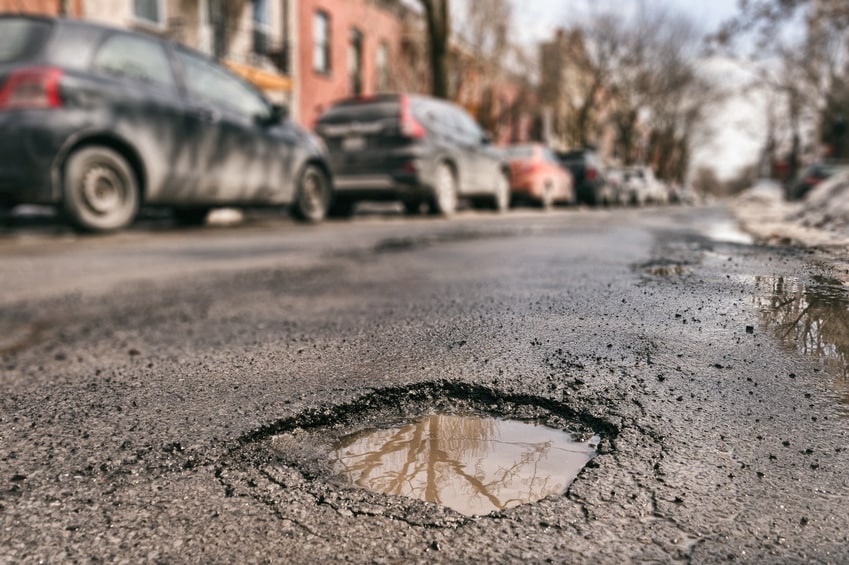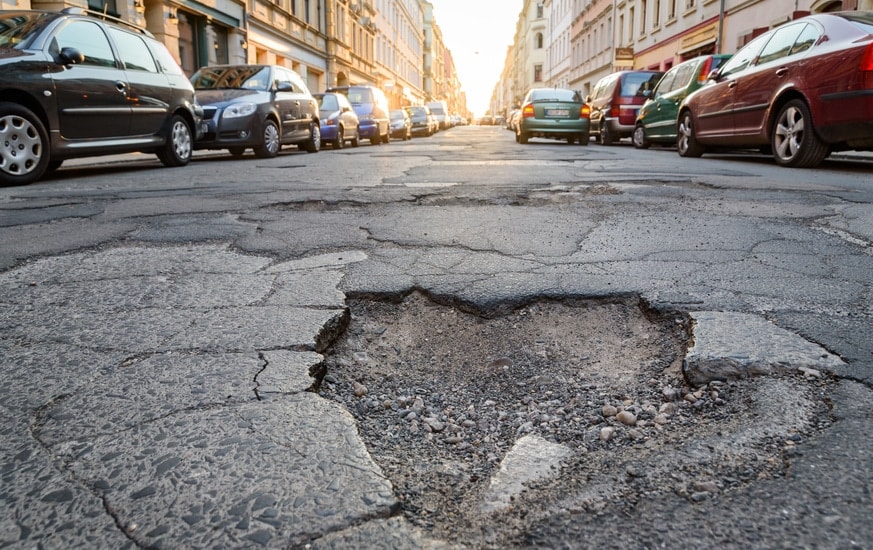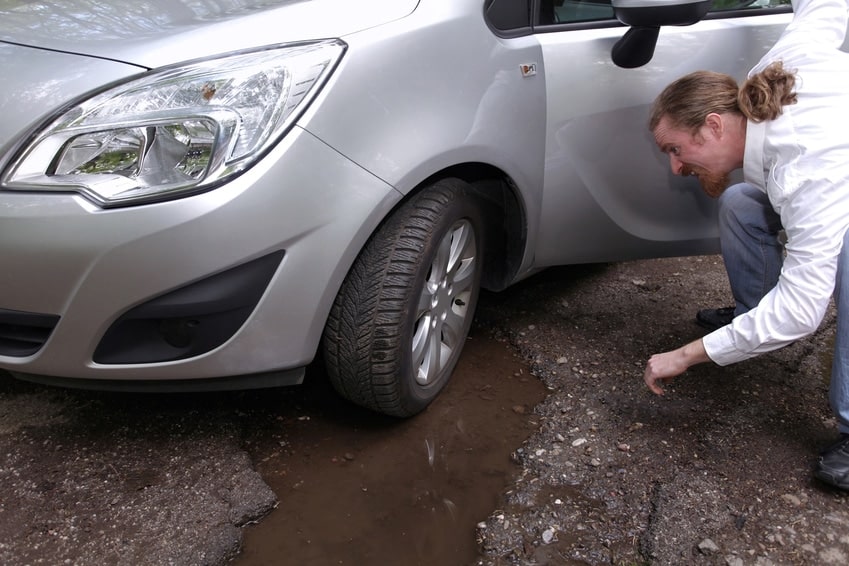Few things enrage road users quite like potholes, and the sad fact is they aren’t going away. Potholes continue to be a major problem on UK roads, causing damage to vehicles and presenting a significant safety risk for drivers and cyclists. But what should you do if your car has been damaged by one?
In this guide, we look at the problem of potholes, giving you advice on how to report them and information on the different options for making a pothole damage claim.
Our guide covers the following:
- Reporting a pothole
- Making a claim for pothole damage
- Common damages caused by potholes
- Driving tips for avoiding potholes
How to Report a Pothole
Spotted a pothole in your local area? If you’re concerned it could cause damage or pose a safety risk, you should report it – here’s how:
- Visit the government’s dedicated report a pothole You’ll be asked to enter the postcode where the pothole is located. This will take you directly to the website of the local council responsible for maintaining the roads in that area.
- To report a pothole, you’ll need to provide the name of the street where it’s located, and an accurate description of its location, shape and size. Be as specific as you can so that the council can easily find and assess it.
- In most cases, local councils aren’t responsible for maintaining major trunk roads, such as motorways and A roads. To report a pothole on a road of this type, call Highways England on 0300 123 5000 or email info@highwaysengland.co.uk.
Councils should respond to your report within five working days, but may not always choose to carry out repair work due to budget restrictions.
Making a Claim for Pothole Damage
If you’re unlucky enough to receive damage from a pothole, you may be able to claim compensation, either from the local council responsible for maintaining the road or from your insurer if you have fully comprehensive insurance.
Making a successful pothole damage claim against a local council will depend on whether or not the pothole has been reported previously. If it hasn’t, the council may not be liable for the damage. To stand the best chance of making a successful damage claim, do the following:
- Record evidence – Directly after receiving damage from a pothole, start preparing the evidence to support your claim. Write an accurate description of what happened and key details about the pothole itself. It’s a good idea to take photographs of the pothole and the surrounding area, as well as the damage inflicted on your car. You should also jot down the contact details of any witnesses that saw the accident happen.
- Get a repair quote – Before you go to the council with your claim, get a repair quote for the damage. Local authorities will want to see how much the damage will cost to repair, so keep a copy of all bills, receipts and invoices.
- Check their liability and do your research – Check through the information provided on your local council’s pothole reporting website to make sure you meet the requirements to make a claim, and that they’re aware of the pothole in question.
- Make your claim and brace for rejection – It’s common for councils to reject pothole damage claims, especially if they can provide a record of regular inspection and maintenance. If this happens, regroup and weigh up the pros and cons of taking your case to the small claims court.
- Negotiate on any offers – Councils don’t hand over money for pothole claims readily, so if they make you an offer, consider taking it, or at least be willing to negotiate. Some money towards the repair cost is better than none at all.
In order to make a claim, follow these steps:
- Contact Highways England – If they think you may be entitled to claim, they’ll send out a damage report form which should be completed and returned as soon as possible. You should also send the following:
- Copies of any bills and invoices detailing the costs of repairing your vehicle.
- Evidence of the accident and damage, including photographs and the contact information of any witnesses.
- A copy of your current MOT certificate.
- In most cases, a decision about your claim will be made in 90 days.
Common Damages Caused by Potholes
Potholes can damage various parts of a car, so you should look for problems in the following areas after hitting one:
Tyres
Tyres take the brunt of pothole strikes and are susceptible to damage such as sidewall bulging, tread splits and flats. A pothole’s hard, sharp edges compress the tyre beyond their limit, causing the rubber to split, stretch or tear. Even if you don’t suffer a flat tyre after hitting a pothole, you should check the wheel for signs of damage which could impact safety or cause further problems.
Wheels
Hit a big enough pothole and the force could buckle or crack the wheel, leading to a range of problems which could be expensive to sort out. If the wheel is bent it may be repairable, but if it’s cracked it will need to be replaced to make sure the tyre has an airtight seal. Hairline cracks can be difficult to spot, so make sure you clean the wheel thoroughly to check for signs of damage. Failing that, have a professional take a look.
Suspension
Sudden jolts in the road can damage the suspension, knocking it out of alignment and causing poor steering and ride performance. Check the struts, shocks and ball joints for signs of sheering or buckling after hitting a pothole. Symptoms of damaged suspension include wandering steering, the car pulling to one side, or unusual vibrations.
Exhaust
If you drive into a deep pothole, the undercarriage can make contact with the road, which can cause severe damage to the exhaust. Check the exhaust pipe for signs of damage, including holes or dents, which could impact performance or cause an increase in emissions.
Driving Tips for Avoiding Pothole Damage
Here, we list driving tips for avoiding potholes and reducing the damage caused by hitting one.
- Keep an eye out for potholes on unfamiliar roads, or in wet weather when they may be hidden by standing water.
- Higher speeds make it harder to avoid potholes and cause more damage, so always stick to the speed limit.
- Stay alert to pedestrians and traffic when avoiding potholes, and don’t swerve unnecessarily.
- Keep a good distance from the car in front so you can check for potholes on the road ahead, and change your course slightly to avoid them.
- Hold the wheel in the 10 and 2 position to maintain control of the car when driving on a road with potholes.
- If you have to drive into a pothole, do so slowly and allow the wheels to roll freely into and out of the hole, without turning the wheel or braking needlessly.
Potholes aren’t going away, so it pays to be prepared. Keep a can of Holts Tyreweld in your car, and you can get back on the road after a pothole has caused your tyre to deflate. For more information about our range of problem-solving car maintenance products, visit the homepage.






